Here James Mishler relates the account of how the Wilderlands of High Fantasy started as a successor to a campaign in Middle Earth that Bob Bledsaw was running. The characters hopped in a portal and found themselves in a strange new world where they could explore and make their mark.
Ironically that nearly describes how my first Wilderlands campaign started. I was running a small gaming group whose characters were known as the Reign. The campaign world was the World of Greyhawk.
By the time they reached 10th level or so I was growing dissatsified with running Greyhawk. The howling emptiness of the 30 mile hexes were tedious to fill. The various realms were too grand. Their scale was beyond what I felt even 10th level characters could measurably effect. Finally I just needed more support due to my relative inexperience at the time.
The Wilderlands freed me from generating the low level details and allowed me to focus on the grand overview. It's scale was near prefect as players would definitely have an impact on the various town and villages described. So one session I annouced that I was moving the campaign over to the Wilderlands. A portal appeared before the Reign, yes I was that heavy handed, and they could go through or be left behind.
When they went through the port they found themselves in the Wilderlands and began exploring. By the time they reached 15th to 16 th level they were well on their way on estabilshing realms of their own. The earliest notes I still have date from this campaign.
▼
Friday, December 26, 2008
Thursday, December 25, 2008
Thursday, December 18, 2008
Judges Guild Modules
Note that Goodman's line of Judges Guild are also included in the sales.
Goodman Judges Guild Page
Thieves of Fortress Badabaskor
Citadel of Fire
Dark Tower
I did the maps and layout for all three and I am co-author (with Bob Bledsaw since it is a remake) of Fortress Badabaskor. So if you want to see how I write up dungeons in addition to mini-setting this is your chance. Badabaskor is probably the closest thing you will get to a sandbox dungeon. Like the original it isn't a place that you hit and clean out. But a location that you can revisit over and over again.
There is now a 10th circle of hell reserved for 3.X stat blocks. I don't have any serious issues with 3.5 as a game or using stat blocks. Writin them however is a whole different story. I have to do a lot technical writing as a software developer often to exacting standards. Writing 3.X stat blocks is the most miseriable piece of technical writing I have ever had to do.
Citade of Fire is similar to Badabaskor but centered around a wizard's tower and the nearby communties. It is probably has the most stuff packed in and includes the citadel, a village, and a necropolis among other thigns.
Dark Tower is a straightforward conversion of the original. However as classic the original was there were some issues in the layout and format and I think even if you don't like 3.X you will find this version a lot easier to use.
So again after Decemeber 31st you won't be able to get this anymore new.
Note: Please don't let the presence of 3.x stat block turn you off of these three modules. We were able to up the page count on all of them so nothing was cut due to the presence of the stat blocks.
Goodman Judges Guild Page
Thieves of Fortress Badabaskor
Citadel of Fire
Dark Tower
I did the maps and layout for all three and I am co-author (with Bob Bledsaw since it is a remake) of Fortress Badabaskor. So if you want to see how I write up dungeons in addition to mini-setting this is your chance. Badabaskor is probably the closest thing you will get to a sandbox dungeon. Like the original it isn't a place that you hit and clean out. But a location that you can revisit over and over again.
There is now a 10th circle of hell reserved for 3.X stat blocks. I don't have any serious issues with 3.5 as a game or using stat blocks. Writin them however is a whole different story. I have to do a lot technical writing as a software developer often to exacting standards. Writing 3.X stat blocks is the most miseriable piece of technical writing I have ever had to do.
Citade of Fire is similar to Badabaskor but centered around a wizard's tower and the nearby communties. It is probably has the most stuff packed in and includes the citadel, a village, and a necropolis among other thigns.
Dark Tower is a straightforward conversion of the original. However as classic the original was there were some issues in the layout and format and I think even if you don't like 3.X you will find this version a lot easier to use.
So again after Decemeber 31st you won't be able to get this anymore new.
Note: Please don't let the presence of 3.x stat block turn you off of these three modules. We were able to up the page count on all of them so nothing was cut due to the presence of the stat blocks.
A note from Goodman Games
Joseph Goodman from Goodman Games has given me my big break with Points of Light and I really appreciate this. So when he asks for help publicizing something I am more than glad to return the favor.
I plan to pick up a couple of DCCs and notably the two biggies Castle White Rock and The Known Realms. At $5 a piece that is a good deal. Considering that most of my gaming is on-line using a virtual table top (Fantasy Grounds) I might actually get some use out of White Rock.
I am always a sucker for reading about another campaign world. It isn't enough that I am a walking encyclopedia on our own planet's history I have to thrown in two dozen more even if they are imaginary.
I plan to pick up a couple of DCCs and notably the two biggies Castle White Rock and The Known Realms. At $5 a piece that is a good deal. Considering that most of my gaming is on-line using a virtual table top (Fantasy Grounds) I might actually get some use out of White Rock.
I am always a sucker for reading about another campaign world. It isn't enough that I am a walking encyclopedia on our own planet's history I have to thrown in two dozen more even if they are imaginary.
Last Call for 3.5!
On December 31, Goodman Games will stop selling its 3.5 products. This is
the last call.
Visit our online store to purchase what is left of our 3.5 product at 50%
off. You can find the online store at
http://www.goodman-games.com/store.html
For the rest of December, you can also visit our PDF store to purchase 3.5
PDF e-books at $2 each. Remember after December 31, they¹re gone forever!
You can find the PDF store at http://goodmangames.rpgnow.com/
Last call!
A note from the Attic
I apologize for the recent lack of posts. The holidays with my family has killed my blogging time. I plan to resume after Christmas. I should have a couple of days to build my post queue again and resume commentary and the map tutorial.
Be Safe and have a Happy Holiday
Be Safe and have a Happy Holiday
Thursday, November 20, 2008
Fight On! #3 is released
The latest edition of Fight On! has been released here. It is a excellent fanzine for old-school gaming. This issue is dedicated to the memory of the late Bob Bledsaw and has permission by his son, Bob Bledsaw II to use Judges Guild content in it's articles.
In particular there is
* Haghill by James Mishler of Adventure Games Publications, detailing a famous village and its surroundings near the City-State of the Invincible Overlord.
* Inferno: The Fifth Circle by Geoffrey O. Dale, author of the original Inferno, taking you deeper into Hell itself!
Then there is my own
* Wilderlands Map 19: The Wild North detailing the lands north of Valon. It is also located west of Blackmoor as detailed in JG's First Fantasy Campaign. I couldn't directly refer to Blackmoor but I made sure that the map and entries worked with the southwestern edge of the Blackmoor map.
Calithena the editor describes the rest of the excellent content of this issue.
You can also learn intriguing tidbits about the history of Judges Guild from Bob Bledsaw II and Bill Owen, the Guild's co-founder, and read a stirring tribute to Bledsaw and the early days of gaming from Bill Webb, co-founder of Necromancer Games! But it's not just the glorious of yesteryear to be found in our pages. David Bowman's contest-winning Spawning Grounds of the Crab-Men and Diana Jones/Indie RPG Award double winner Jason Morningstar's first honorable mention Khas Fara give you two tough new adventures to tackle, the latter of which can be played with traditional fantasy games or with The Shadow of Yesterday. Gabor Lux, the Hungarian Prince of Swords & Sorcery, takes you inside his Fomalhaut Campaign. Our front cover was penned by Len Cain of Berkeley gaming legend. Baz Blatt brings you new demons for Empire of the Petal Throne, while Max Davenport gives us some terrible and zany monsters for Mutant Future! And Fight On! stalwarts and newcomers Jeff Rients, Steve Zieser, Kevin Mayle, Lee Barber, Patrick Farley, Del Beaudry, Vincent Baker, Kesher, John Miskimen, Age of Fable, Calithena, and many more are back and ready to rock your game with the newest tables, tricks, sorcery, monsters, and mayhem their deviant minds can devise!
In particular there is
* Haghill by James Mishler of Adventure Games Publications, detailing a famous village and its surroundings near the City-State of the Invincible Overlord.
* Inferno: The Fifth Circle by Geoffrey O. Dale, author of the original Inferno, taking you deeper into Hell itself!
Then there is my own
* Wilderlands Map 19: The Wild North detailing the lands north of Valon. It is also located west of Blackmoor as detailed in JG's First Fantasy Campaign. I couldn't directly refer to Blackmoor but I made sure that the map and entries worked with the southwestern edge of the Blackmoor map.
Calithena the editor describes the rest of the excellent content of this issue.
You can also learn intriguing tidbits about the history of Judges Guild from Bob Bledsaw II and Bill Owen, the Guild's co-founder, and read a stirring tribute to Bledsaw and the early days of gaming from Bill Webb, co-founder of Necromancer Games! But it's not just the glorious of yesteryear to be found in our pages. David Bowman's contest-winning Spawning Grounds of the Crab-Men and Diana Jones/Indie RPG Award double winner Jason Morningstar's first honorable mention Khas Fara give you two tough new adventures to tackle, the latter of which can be played with traditional fantasy games or with The Shadow of Yesterday. Gabor Lux, the Hungarian Prince of Swords & Sorcery, takes you inside his Fomalhaut Campaign. Our front cover was penned by Len Cain of Berkeley gaming legend. Baz Blatt brings you new demons for Empire of the Petal Throne, while Max Davenport gives us some terrible and zany monsters for Mutant Future! And Fight On! stalwarts and newcomers Jeff Rients, Steve Zieser, Kevin Mayle, Lee Barber, Patrick Farley, Del Beaudry, Vincent Baker, Kesher, John Miskimen, Age of Fable, Calithena, and many more are back and ready to rock your game with the newest tables, tricks, sorcery, monsters, and mayhem their deviant minds can devise!
Wednesday, November 19, 2008
A 911 call from the Attic
My favorite RPG of all times is Harnmaster. For me Harnmaster has a perfect blend of playability and realism. I rarely have the chance to GM the game as the group I play with prefers GURPS. This isn't a big problem as it is my second favorite RPG. It is been nearly 20 years since I last GMed Harn.
A little background on Harnmaster. It is a RPG originally written by N Robin Crossby and the Columbia Games Crew. In the late 90s Columbia and NRC split causing Harnmaster to split into two editions Harnmaster 2nd edition and Harnmaster Gold. Finally Columbia Games put out a 3rd edition that collected errata and added esstential element for a medieval RPG the most important of which was mounted combat! All four versions of Harnmaster are compatible and GMs have freely intermixed rules between them.
Columbia Games
Kelestia
Harnmaster is geared towards playing in a low magic low fantasy medieval world like... Harn. However aside from the dieties it has few Harn centric details and can be used for any medieval fantasy RPG.
Harnmaster has some similarity to Runequest in how characters are presented. Skills are percentile and attributes are on a nominal 3 to 18 scale. Where Harnmaster really excels in its brutally realistic combat system. Harnmaster rules front load all the calculations before you play. Actual play is quick as it involves some rolls and chart lookup. You can see the combat cards here
Skills involves rolling low on percentile dice. Any roll ending in a zero or five is a critical. Whether is it is a success or failure depends on if you roll under your skill.
The combat basic procedure is
1) Side A rolls attack
2) Side B roll defense
3) Cross index the level of success (Critical Success, Marginal Success, Marginal Failure, Critical Failure) on the combat chart and apply the result.
4) If you hit you will get to roll a number of D6. Add the impact of the weapon aspect to the roll. Aspects can be point, edge or blunt. Typically range from 0 to 11. This givesthe total impact of the blow.
5) Roll hit location. You can aim high low or middle.
6) Subtract the Armor in that location
7) If the remaining impact is great than zero look up what type of injury you take for that hit location.
You can take a minor, serious, or grievous injury. You record each injury separately. The nominal effect is rated in injury levels. A S2 result means you have a serious injury with 2 levels of damage. Each level subtracts one from any roll with d6s against your attributes or -5 per level for skill rolls. Aside from the injury levels many wounds have special saves. Shock, fumble, stumble, amputation, and the dreaded kill roll. The type of save and the injury you substained determine how many d6s you roll against the attribute to save.
For example if you took a M1 hit to the hand requires a fumble roll if you were holding something in that hand. Normally it is a 1d6. Unless you have a crap dexterity you can't fail. However in a fight where you took a S2 wound to the chest, a pair of M1 wounds to the thigh, and a S3 gash to the upper arm you are looking at rolling that 1d6 at a +7 modifier. The more injuries you take the worse these saves get even the minor ones.
Healing well, it has a detailed resolution as well. Let's say a severely injured character isn't going to be getting up for the next couple of weeks.
I admit writing it down like this makes it seems very complicated and detailed obsessed. However in actual play it flows very fast without a lot of headaches. This is because of the design of the combat card combined with the fact that the situational modifiers are very few and well thought out.
Two weeks ago I get a call from my friend Josh who lives in Pittsburgh. He wants to try Harnmaster after reading Cow in the Attic. Between family, work, the National Guard, and college he wanted to play an RPG that was utterly brutal and Harnmaster seems to fit the bill.
I readily agreed and went down to Pittsburgh the following weekend. The two of us managed to convince another friend of mine Scott to play as well. He not a big fan of RPGs that have you roll your character but was willing to try.
Lucky for me Columbia Games released an excellent little intro adventure called Field of Daisies for Harnmaster. So I decided to use that. When I got there I offered them to use the pre-gen character in Field of Daises or roll up their own.
So we sat down and rolled up a pair of Harnmaster characters. I decided that Slot #1 was going to be a Shek-Pvar, a Harnic Mage, Slot #2 would be the mage's bodyguard, and if a third player showed up Slot #3 a cleric of one of the good dieties. Now Harnmaster Magic is useful but not overwhelming. The mage + bodyguard combo should be able to deal with Field of Daisies.
Rolling up a Harnmaster Characters involves a lot of calculation and table lookup. Part of this is due to the fact they front load everything to make actual play run smooth.
Here is where 20 years of not actively using Harnmaster hurt. I should have photocopied the tables so that the both players could have used them at the various steps. Another thing about Harnmaster is that attribute dont' gimp your characters. A lot of skills involves averaging three attribute together so low stats are not an issue. Even so there are seven key attributes for these I am generous and have the players roll 4d6 reroll ones drop the lowest and do this 8 times. This is similar to how I did it for AD&D. Josh wants to be the magic user so has a 17 Aura the prime state for mages. Scott puts some great stats into his physical abilities which he his lowest in agility. Agility represent body dexterity, while dexterity represents manual dexterity.
In Harnmaster who your parents are is important for part of the initial batch of skills you get. Odds are you will be a child of a serf. In the 80s when I ran a succession of Harn campaign there were a lot of runaway serfs in the group. Josh parents turns out to be indeed serfs. Scott however rolls a 03 what happens to be a... slave. Scott gets a sour expression on his face at that. I explain that slavery existed in the middle age however it was not prevalent. Serfdom was the order of the day. I told he will still be the bodyguard but he enslaved to the Mage's Guild assigned to protect Josh's Mage.
Character generation proceeds until when we get to the Medical Table. For every roll on the medical table you get 2 points to raise your attributes. There is a 30% that roll will come to nothing. Most results are bad but a few are benefits like left handed which gives you 1 to 2 points of dexterity. Decks of many things anybody.
Josh decides to take three rolls gets no medical traits twice and an allergy to shell fish. Now that may sound silly until you are stuck in a seaside village and all there is to eat is clams.
Scott... poor Scott. He also takes three rolls. First roll he is allergic to fowl. Considering 90% of the population of Harn lives in rural villages this is going to be an issue. Then 2nd roll, ....
Lame
His left leg was chopped off when he was young leaving him with a pegleg. Scott throws up his hands and says "I am literally a gimp character." As this was a one shot we decide to go with this. The third roll was No Medical Trait with Scott giving a sigh of relief.
Being Lame meant his final Agility was 3. His normal combat move being a 1 hex and running 3 hexes. An average character would have a combat move of 10 hexes and running of 20 hexes. He not moving fast.
Then they came to the psyche table. Which is just like the Medical Table except it is psychological disorder. You have the option of one roll for +3 to any attribute except will. Josh elects to roll and comes with a No Pysche Trait result. Scott elects to pass.
When the character are finished up Josh has a Pelahn Shek-Pvar (Pelahn= Fire) with some nice offensive spells. A interesting thing about his character was that he was a bastard of a freeman born to a serf mother. Josh's high Aura attracted a travelling mage who decided to buy out his labor with his lord and have Josh trained as a mage. An interesting part of Josh's character was he was able to max out his dodge to above 100%. (Harnmaster allows skills greater than 100%)
Scott had a lame bodyguard. However he has an outstanding calculated Endurance of 19 (on a 3 to 18 scale). In Harnmaster a lot of saving throws are made against endurance. Most initial injuries he won't be effected by as it is impossible for him to fail. And he can last a lot longer in most fights. Scott's lost his leg while young and the same mage who found Josh took pity on him and bought him to serve as a servant. Due to Scott's great strength and endurance he was given weapon training as a bodyguard.
So I thought. Understand I GMed Harn 1st Edition and for this I was using 3rd Edition for the first time. There was an important change to the combat roll that made this not as useful.
For new games I run a combat encounter before starting play so that players can tweak their character before start of play. They found a couple of bandits and it went well. One of the bandits had a sling and inflicted a nasty bruise to Josh's hip. Because Sling bullets are considered fast missile (compared to a thrown axe or javelin) you can't dodge. But you can use a shield to block them. So Josh rearranged his skill buys to boost up his shield and bought a door errr tower shield.
The back story was that Josh was just made a journeyman of the Shek-Pvar and let loose for a year and a day to bring back three interesting magic items and three pieces of lore so that he could become a master. He decided to journey north to his home village of Falkith to visit his father who was a yeoman beadle.
When they got there they first encountered the woodward (the guy who manages the local forest so that people don't strip it bare for firewood and herbs). The woodward had been illegally poaching rabbits from the woods and was cooking one up in the back. When the characters came up the road he doused the fire, rushed out front and started to act belligerent. However the character didn't really take notice and were able to get directions to the manor.
Entering the village they found most of the men of the village and the manor lord (a knight) had gathered on the green and were discussing the disappearance of two serf boys. It been two days and they haven't found any sign of them in the surrounding country side. The lord was in the middle of ordering the yeoman to go to the hundred moot (the village where local court was held) and post notice that the two were runaway serfs.
At this point everybody notices the PCs and started questioning them as to their business. Josh explained about his father and the tension immediately broke. They explained that his father passed away and the current yeoman was his cousin. Note that due to Josh's clothing and the fact he had a armed bodyguard signaled to everyone that he had done very well since leaving the village. The yeoman invited Josh to stay at his cottage. And the Lord congratulated Josh on his success. In honor of Josh's return he ordered that a hog's head and some pork hocks be sent to the yeoman so they could have a little family feast. The lord also invited Josh and Scott over for breakfast in the morning. Note that despite Josh's serf background he represented a source of outside news. So the lord had ulterior motives other than being hospitable.
The villagers concluded the meeting and Josh, his yeoman cousin, and Scott when off to the cottage. There they found a large three room hut where one room was used as the living area, the second as a bedroom, and next to the bedroom was where they kept the family livestock, including chickens to Scott discomfort. After the feast there was talk about what happened to Josh's father. At this point they learned about a local cave that was supposely haunted.
While they were turning in for bed. The eldest son offered his blanket to Josh and Scott. To my surprise the players looked embrassed at this. Apparently I was doing a good job describing the surrounding and they knew that despite being a yeoman Josh's cousin didn't have much. Looking on their character sheets the two realized that they had their own blankets and so graciously refused.
At dawn they awoke. Josh and Scott decided to check out the cave instead of escorting his cousin to the hundred moot. They walked down to the lord's manor to eat breakfast. The manor looks somewhat like a wild west stockade with only one wooden tower. Only the manor house itself was made of stone. When they walked in they saw the alewife (the female servant in charge of maintaining the lord stock of ales, and other liquors). She showed to the great hall of the manor. There they saw the cook preparing breakfast over a smoky hearth along with the lord's old uncle sitting at the table and complaining about everything.
After several minutes the lord came down and breakfast was served. The conversation revolved around news from the outside which Josh and Scott did a great job in making stuff up despite their lack of knowledge of Harn along with the two of them asking about the cave. Every so often the Uncle piped in with his bombastic comments.
Note that I do voices. I am not a professional by any means but I can do it well enough to give each of my NPCs a distinct voice. I don't try to do a true falsetto for my female NPCs I do raise my voice a pitch or two.
They learned that the local cave was considered haunted and nobody ever goes in there. So after breakfast they thanked the lord and decided to go exploring.
Now when a Harn adventure has a cave they have a cave. The floors are uneven they show sudden drops and climbs, tight spots, and passageways going every which way. Field of Daisies was no different.
The front part of the cave was relatively innocuous more of a puzzle challenge than anything truly dangerous. The only part that could serious hurt them was a patch of M'nogi or the Harnic Green Slime. Unlike D&D's slime, the M'nogi was a mushroom with a acid filled interior. If you pick one it is very easy to squirt the acid out randomly often severely burning the character. And if you fall into a patch it was a bad day for everyone.
Apparently the whole "realism" thing that I was doing in my description was really getting to the players in a good way by raising the tension. Much in the way a good GM of Call of Cthulu will do while investigators explore that creepy old house they shouldn't.
Also remember that despite Scott's one leg he has tremendous upper body strength so his climbing and other physical skill were slightly above average.
The climax of this exploration came when they reached a bottleneck. The cave narrowed to a single passageway which dipped down and up again much like a drain pipe under a sink. The effect was that nothing bulky or over 5' in length could be taken. This meant Scott's spear and Josh's tower shield. Luckily Scott had a round shield that could be taken.
So they climbed down and out again where the cave broadened again. Here it opened into a large chamber. The creepiness started to peg too high on the meter as the both of them began to think this whole cave business was a bad bad idea.
It was...
The rear of the cave system was inhabited by two Vlasta or Eaters of Eyes. They are about as big as a chicken with no feathers with claws and a wicked beak. They liked to leap high and get at the face of their target trying to peck at anything especially the eyes.
While setting up the module, I rolled the dice roll to see what type of setup the vlasta would be in. As it turned out there was only one near the PCs.
One proved to be enough.
While the players were debating I started scratching the underside of the table. They didn't seem to notice consciously that I was doing this but the conversation started to take a "Get the hell out of here turn". I then threw some dice and announced that they heard some stone clattering.
They immediately began to retreat back to the bottleneck. It was then I had the Vlasta attack.
After rolling who it will target the thing leaped onto Scott. Scott failed his dodge while I got a marginal success on the hit. I had it aim high and rolled for hit location ...
the face.
We all groaned as the Vlasta had a 70% chance of ripping Scott's eye out on a face shot. Luckily I rolled a 93 so it was a serious stab wound (S2) to the face.
Josh cast a Orb of Zetara which creates a ball of ethereal fire. Normally it is used for lighting but if you hit somebody with it using a touch attack it will burn them.
Scott stabbed at the Vlasta with his dagger. Now understand that Harnmaster has 10 second combat rounds. So it isn't like you are stabbing at your face with a dagger. Rather you have this thing trashing around pecking at you and you try to get a good blow in.
For a defense I choose a counter attack figuring the Vlasta is going all out. Well Scott missed and the Vlasta got a critical success. This time the hit location was in the neck. Scott got a serious stab wound to the neck (S3).
Here where new edition of Harnmaster got me. Harnmaster had shock rolls after every injury. If you failed to roll beneath your endurance you passed out. In 1st edition the roll was whatever injury level you took for that blow along with +1 for every two levels of injury you already had. This was perhaps too generous as it left a lot of fights where both sides unable to do anything because they were so injured.
The new rule for 2nd and 3rd edition. Is that number of d6 you roll is the TOTAL of all your injuries. So when the Vlasta nailed Scott he had to roll 5d6 (S2 in the face + a S3 in the neck) under a 19. And Scott blew the shock roll and passed out.
In the first harnmaster combat ever for these guys one of them gets laid out in two rounds. Understand this took about 2 minutes of real time. Most of that me looking up what the Orb of Zetara did. So it was BAM! and BAM! Scott is down.
Josh punches the Vlasta with the Orb and burns it. The Vlasta then turns around aims high and leaps at Josh. Josh's 100+ dodge saves him. Josh then punches the Vlasta again. The Vlasta counterattack fails and Josh succeeds and again burns the Vlasta. Now the Vlasta has only a 8 endurance so the two minor burns combined to a 2d6 shock roll which the Vlasta fails.
Stunned at this turn of events. Josh begins first aiding Scott, poorly. Then uses a healing salve that allows the wounds to be healing quicker once they get out of the cave. Scott wakes up and succeeds on his final shock roll. If he had failed he would be no condition to fight.
The two of them decide to leave. Then I started scratching the underside of the table which this time they noticed. They listen and heard clattering of more stones. The second Vlasta had heard the fight and was coming to investigate.
The players didn't know there was only one more so decided to get out. However Josh didn't want it following them. So he casted another spell called lake of fire. It doesn't do much damage but it engulf a rather large area in flames. Josh figures whatever out there would be scared off.
He successfully casted the spell and the whole rear section of the cave was brief engulfed in a fireball. They hear the scream of the Vlasta as it runs away to its lair. But they also hear two human screams.
Unbeknownst to the two the cave connects to an abandoned Khuzan (Dwarven) Mine. Off of the main mine shaft the dwarves carved out a series of rooms as a small living quarter and storeroom. In the back of one of the room was a secret room that connected the rooms to the cave. If something would happened in the mine this would be an alternate route out.
A couple of days ago a peddler was fishing in a pond with his feet in the water. While fishing his feet hit something solid in the musk. He pulled it out and turned out to be a dagger of a dark god named Morgath. It primary power was to instill a compulsion to kill in the bearer to the point where he had to take a sentient life every 13 days. The peddler was greatly disturbed by this, not being an evil man. So he fled into this cave eventually discovering the secret door. He has spent the last two weeks in here trying to resist the compulsion.
However two serf boys from the villages dared each other to go into the cave two days ago. They managed to get all the way into the rear of the cave when they were attacked by the Vlasta. One of them was killed and the other fled further in. The peddler heard this and rescued him. They wound up back in the secret chamber.
However there was enough of the dagger's compulsion on him that the peddler decided tie the body up until he decided what to do. With food running out and the dagger's hold increasing the peddler is on the verge of murdering the child. When Josh casted the Lake of Fire I ruled that the secret door wasn't a barrier and thus the body and the peddler were effected.
Attracted by the shouts, Josh and Scott began searching the chamber. They found the secret door. When they opened they heard the peddler smacking the body around telling him to shut up. The boy is crying that he wants to go home.
The two decided to rush the chamber. They charged in and announced that on the authority of the Mage's Guild the peddler is under arrest. The peddler panics and thinks they are here for him and the magical dagger. He lunges at the box where he is keeping the dagger and is able to retrieve it. Scott steps up and misses while the peddler dodges. Josh creates another Orb of Zetara. The next round the peddlers lunges at Scott.
After the fight with the first Vlasta, Josh takes Scott's shield and never gives it back. So Scott is stuck using his dagger parry or his dodge both of which sucks. He blows his dodge and the Peddler plunges the dagger into Scott's already injured neck getting a Kill result (K4). Now K4 isn't instant death you still get a save. 4d6 roll lower than Scott endurance of 19 not affected by injury. Scott saves so the K4 is converted to a grievous wound (G4). However this wound plus the other neck stab and the face stab combine into a 9d6 shock roll versus a 19 endurance. Scott fails and passes out.
Josh then punches the Peddler with the Orb and succeeds. Josh dodges the next thrust of the dagger and punches again with the orb, succeeding. The Peddler has ordinary stats and winds up failing the 2d6 shock roll (two minor burns M1 each). The Peddler passes out.
Josh then reaches down and picks up the dagger. The compulsion to kill takes hold of him after failing the will roll and Josh plunges the Dagger into the peddler.
Josh did a nice bit of role-playing while he sat in the room considering whether he would kill Scott and the boy as well. The dagger's compulsion was satisfied for 13 days so it was Josh's choice. In the end he sheathed the dagger and wraps it up.
Scott wakes up and doesn't make his final shock roll so he in a dazed condition for at least four hours. Josh goes into the dwarven mine and finds the exit to be blocked by stones. He is able to clear enough to allow the boy to escape. Then returns to the cave and hunts down the remaining Vlasta. I do mean he hunts down. Josh is determined to make the Vlasta his prey. He succeeds in killing the last Vlasta.
When Josh returns to the secret chambers he finds the villagers had cleared enough stone to allow both Josh and Scott to exit by the old mine entrance. Josh and Scott are hailed as heroes while Scott is given a room at the manor to recuperate. Josh decides that he has one of his three items and carefully bundles the dagger. Scott recovers in five weeks with no infections however suffers a loss in Stamina due to the multiple neck wounds and Comeliness due to the facial scars.
Overall the game was a success and the players had a lot of fun.
The Pluses
I had forgotten how much I really enjoyed GMing Harnmaster.
Once again the brutality and playability of combat system pulled the players into the game rather than driving them out of it. When I DMed harnmaster in the late 80s it's graphic nature never failed to make players go "Combat is serious."
I was in a groove GMing wise and managed to build tension. This is my weakest aspect as a GM and I am glad to have pulled this off as Field of Daisies depends on it.
The Minuses
Need to photocopy a lot more charts than I did for character creation. I forgotten I did this for 1st edition.
I also need to create a table of triple values so players can quickly compute the average. For example a total of 42 means the average of three values is 14 the same for 43, 44. For 45 the average becomes 15.
I am not sure about this new shock roll system. I see what they were trying to fix with 1st edition. But this is like way to brutal for even my taste. I may go with a d6 roll based on whatever injury they took that round plus +1 to the roll for each prior injury. So in the first fight Scott would have been faced with a 3d6+2 shock roll instead of 5d6. 4d6+5 for the second fight's shock roll.
Probably use my Majestic Wilderlands instead of Harn for the next game. For two reasons, first my demographics and social structure borrows a lot from Harn already. Second my Harn stuff is not organized for actual play but rather for easy reading. I just don't want to spend the time doing the reorganization when the Majestic Wilderlands is right there in my head and organized in my notebook.
I should have given Scott better Armor and equipment. Despite having one leg, if he was properly armored up he could have shined in the combat situations rather than being overshadowed by Josh. Looks like in Harnmaster proper equipment is essential as it is in real life.
Josh and Scott said that the whole village sequence really drew them in especially the bit about the hog's head and hocks along with the offering of the blanket. Character generation was a bit of
chore. Scott swore if he made another harnmaster character he would never roll on the medical or pysche table again. Both agreed that combat seemed complex but played very fast.
Provided I can avoid things like Cow in the Attic and One legged dwarves err characters I can continue to make Harnmaster a fun experience.
A little background on Harnmaster. It is a RPG originally written by N Robin Crossby and the Columbia Games Crew. In the late 90s Columbia and NRC split causing Harnmaster to split into two editions Harnmaster 2nd edition and Harnmaster Gold. Finally Columbia Games put out a 3rd edition that collected errata and added esstential element for a medieval RPG the most important of which was mounted combat! All four versions of Harnmaster are compatible and GMs have freely intermixed rules between them.
Columbia Games
Kelestia
Harnmaster is geared towards playing in a low magic low fantasy medieval world like... Harn. However aside from the dieties it has few Harn centric details and can be used for any medieval fantasy RPG.
Harnmaster has some similarity to Runequest in how characters are presented. Skills are percentile and attributes are on a nominal 3 to 18 scale. Where Harnmaster really excels in its brutally realistic combat system. Harnmaster rules front load all the calculations before you play. Actual play is quick as it involves some rolls and chart lookup. You can see the combat cards here
Skills involves rolling low on percentile dice. Any roll ending in a zero or five is a critical. Whether is it is a success or failure depends on if you roll under your skill.
The combat basic procedure is
1) Side A rolls attack
2) Side B roll defense
3) Cross index the level of success (Critical Success, Marginal Success, Marginal Failure, Critical Failure) on the combat chart and apply the result.
4) If you hit you will get to roll a number of D6. Add the impact of the weapon aspect to the roll. Aspects can be point, edge or blunt. Typically range from 0 to 11. This givesthe total impact of the blow.
5) Roll hit location. You can aim high low or middle.
6) Subtract the Armor in that location
7) If the remaining impact is great than zero look up what type of injury you take for that hit location.
You can take a minor, serious, or grievous injury. You record each injury separately. The nominal effect is rated in injury levels. A S2 result means you have a serious injury with 2 levels of damage. Each level subtracts one from any roll with d6s against your attributes or -5 per level for skill rolls. Aside from the injury levels many wounds have special saves. Shock, fumble, stumble, amputation, and the dreaded kill roll. The type of save and the injury you substained determine how many d6s you roll against the attribute to save.
For example if you took a M1 hit to the hand requires a fumble roll if you were holding something in that hand. Normally it is a 1d6. Unless you have a crap dexterity you can't fail. However in a fight where you took a S2 wound to the chest, a pair of M1 wounds to the thigh, and a S3 gash to the upper arm you are looking at rolling that 1d6 at a +7 modifier. The more injuries you take the worse these saves get even the minor ones.
Healing well, it has a detailed resolution as well. Let's say a severely injured character isn't going to be getting up for the next couple of weeks.
I admit writing it down like this makes it seems very complicated and detailed obsessed. However in actual play it flows very fast without a lot of headaches. This is because of the design of the combat card combined with the fact that the situational modifiers are very few and well thought out.
Two weeks ago I get a call from my friend Josh who lives in Pittsburgh. He wants to try Harnmaster after reading Cow in the Attic. Between family, work, the National Guard, and college he wanted to play an RPG that was utterly brutal and Harnmaster seems to fit the bill.
I readily agreed and went down to Pittsburgh the following weekend. The two of us managed to convince another friend of mine Scott to play as well. He not a big fan of RPGs that have you roll your character but was willing to try.
Lucky for me Columbia Games released an excellent little intro adventure called Field of Daisies for Harnmaster. So I decided to use that. When I got there I offered them to use the pre-gen character in Field of Daises or roll up their own.
So we sat down and rolled up a pair of Harnmaster characters. I decided that Slot #1 was going to be a Shek-Pvar, a Harnic Mage, Slot #2 would be the mage's bodyguard, and if a third player showed up Slot #3 a cleric of one of the good dieties. Now Harnmaster Magic is useful but not overwhelming. The mage + bodyguard combo should be able to deal with Field of Daisies.
Rolling up a Harnmaster Characters involves a lot of calculation and table lookup. Part of this is due to the fact they front load everything to make actual play run smooth.
Here is where 20 years of not actively using Harnmaster hurt. I should have photocopied the tables so that the both players could have used them at the various steps. Another thing about Harnmaster is that attribute dont' gimp your characters. A lot of skills involves averaging three attribute together so low stats are not an issue. Even so there are seven key attributes for these I am generous and have the players roll 4d6 reroll ones drop the lowest and do this 8 times. This is similar to how I did it for AD&D. Josh wants to be the magic user so has a 17 Aura the prime state for mages. Scott puts some great stats into his physical abilities which he his lowest in agility. Agility represent body dexterity, while dexterity represents manual dexterity.
In Harnmaster who your parents are is important for part of the initial batch of skills you get. Odds are you will be a child of a serf. In the 80s when I ran a succession of Harn campaign there were a lot of runaway serfs in the group. Josh parents turns out to be indeed serfs. Scott however rolls a 03 what happens to be a... slave. Scott gets a sour expression on his face at that. I explain that slavery existed in the middle age however it was not prevalent. Serfdom was the order of the day. I told he will still be the bodyguard but he enslaved to the Mage's Guild assigned to protect Josh's Mage.
Character generation proceeds until when we get to the Medical Table. For every roll on the medical table you get 2 points to raise your attributes. There is a 30% that roll will come to nothing. Most results are bad but a few are benefits like left handed which gives you 1 to 2 points of dexterity. Decks of many things anybody.
Josh decides to take three rolls gets no medical traits twice and an allergy to shell fish. Now that may sound silly until you are stuck in a seaside village and all there is to eat is clams.
Scott... poor Scott. He also takes three rolls. First roll he is allergic to fowl. Considering 90% of the population of Harn lives in rural villages this is going to be an issue. Then 2nd roll, ....
Lame
His left leg was chopped off when he was young leaving him with a pegleg. Scott throws up his hands and says "I am literally a gimp character." As this was a one shot we decide to go with this. The third roll was No Medical Trait with Scott giving a sigh of relief.
Being Lame meant his final Agility was 3. His normal combat move being a 1 hex and running 3 hexes. An average character would have a combat move of 10 hexes and running of 20 hexes. He not moving fast.
Then they came to the psyche table. Which is just like the Medical Table except it is psychological disorder. You have the option of one roll for +3 to any attribute except will. Josh elects to roll and comes with a No Pysche Trait result. Scott elects to pass.
When the character are finished up Josh has a Pelahn Shek-Pvar (Pelahn= Fire) with some nice offensive spells. A interesting thing about his character was that he was a bastard of a freeman born to a serf mother. Josh's high Aura attracted a travelling mage who decided to buy out his labor with his lord and have Josh trained as a mage. An interesting part of Josh's character was he was able to max out his dodge to above 100%. (Harnmaster allows skills greater than 100%)
Scott had a lame bodyguard. However he has an outstanding calculated Endurance of 19 (on a 3 to 18 scale). In Harnmaster a lot of saving throws are made against endurance. Most initial injuries he won't be effected by as it is impossible for him to fail. And he can last a lot longer in most fights. Scott's lost his leg while young and the same mage who found Josh took pity on him and bought him to serve as a servant. Due to Scott's great strength and endurance he was given weapon training as a bodyguard.
So I thought. Understand I GMed Harn 1st Edition and for this I was using 3rd Edition for the first time. There was an important change to the combat roll that made this not as useful.
For new games I run a combat encounter before starting play so that players can tweak their character before start of play. They found a couple of bandits and it went well. One of the bandits had a sling and inflicted a nasty bruise to Josh's hip. Because Sling bullets are considered fast missile (compared to a thrown axe or javelin) you can't dodge. But you can use a shield to block them. So Josh rearranged his skill buys to boost up his shield and bought a door errr tower shield.
The back story was that Josh was just made a journeyman of the Shek-Pvar and let loose for a year and a day to bring back three interesting magic items and three pieces of lore so that he could become a master. He decided to journey north to his home village of Falkith to visit his father who was a yeoman beadle.
When they got there they first encountered the woodward (the guy who manages the local forest so that people don't strip it bare for firewood and herbs). The woodward had been illegally poaching rabbits from the woods and was cooking one up in the back. When the characters came up the road he doused the fire, rushed out front and started to act belligerent. However the character didn't really take notice and were able to get directions to the manor.
Entering the village they found most of the men of the village and the manor lord (a knight) had gathered on the green and were discussing the disappearance of two serf boys. It been two days and they haven't found any sign of them in the surrounding country side. The lord was in the middle of ordering the yeoman to go to the hundred moot (the village where local court was held) and post notice that the two were runaway serfs.
At this point everybody notices the PCs and started questioning them as to their business. Josh explained about his father and the tension immediately broke. They explained that his father passed away and the current yeoman was his cousin. Note that due to Josh's clothing and the fact he had a armed bodyguard signaled to everyone that he had done very well since leaving the village. The yeoman invited Josh to stay at his cottage. And the Lord congratulated Josh on his success. In honor of Josh's return he ordered that a hog's head and some pork hocks be sent to the yeoman so they could have a little family feast. The lord also invited Josh and Scott over for breakfast in the morning. Note that despite Josh's serf background he represented a source of outside news. So the lord had ulterior motives other than being hospitable.
The villagers concluded the meeting and Josh, his yeoman cousin, and Scott when off to the cottage. There they found a large three room hut where one room was used as the living area, the second as a bedroom, and next to the bedroom was where they kept the family livestock, including chickens to Scott discomfort. After the feast there was talk about what happened to Josh's father. At this point they learned about a local cave that was supposely haunted.
While they were turning in for bed. The eldest son offered his blanket to Josh and Scott. To my surprise the players looked embrassed at this. Apparently I was doing a good job describing the surrounding and they knew that despite being a yeoman Josh's cousin didn't have much. Looking on their character sheets the two realized that they had their own blankets and so graciously refused.
At dawn they awoke. Josh and Scott decided to check out the cave instead of escorting his cousin to the hundred moot. They walked down to the lord's manor to eat breakfast. The manor looks somewhat like a wild west stockade with only one wooden tower. Only the manor house itself was made of stone. When they walked in they saw the alewife (the female servant in charge of maintaining the lord stock of ales, and other liquors). She showed to the great hall of the manor. There they saw the cook preparing breakfast over a smoky hearth along with the lord's old uncle sitting at the table and complaining about everything.
After several minutes the lord came down and breakfast was served. The conversation revolved around news from the outside which Josh and Scott did a great job in making stuff up despite their lack of knowledge of Harn along with the two of them asking about the cave. Every so often the Uncle piped in with his bombastic comments.
Note that I do voices. I am not a professional by any means but I can do it well enough to give each of my NPCs a distinct voice. I don't try to do a true falsetto for my female NPCs I do raise my voice a pitch or two.
They learned that the local cave was considered haunted and nobody ever goes in there. So after breakfast they thanked the lord and decided to go exploring.
Now when a Harn adventure has a cave they have a cave. The floors are uneven they show sudden drops and climbs, tight spots, and passageways going every which way. Field of Daisies was no different.
The front part of the cave was relatively innocuous more of a puzzle challenge than anything truly dangerous. The only part that could serious hurt them was a patch of M'nogi or the Harnic Green Slime. Unlike D&D's slime, the M'nogi was a mushroom with a acid filled interior. If you pick one it is very easy to squirt the acid out randomly often severely burning the character. And if you fall into a patch it was a bad day for everyone.
Apparently the whole "realism" thing that I was doing in my description was really getting to the players in a good way by raising the tension. Much in the way a good GM of Call of Cthulu will do while investigators explore that creepy old house they shouldn't.
Also remember that despite Scott's one leg he has tremendous upper body strength so his climbing and other physical skill were slightly above average.
The climax of this exploration came when they reached a bottleneck. The cave narrowed to a single passageway which dipped down and up again much like a drain pipe under a sink. The effect was that nothing bulky or over 5' in length could be taken. This meant Scott's spear and Josh's tower shield. Luckily Scott had a round shield that could be taken.
So they climbed down and out again where the cave broadened again. Here it opened into a large chamber. The creepiness started to peg too high on the meter as the both of them began to think this whole cave business was a bad bad idea.
It was...
The rear of the cave system was inhabited by two Vlasta or Eaters of Eyes. They are about as big as a chicken with no feathers with claws and a wicked beak. They liked to leap high and get at the face of their target trying to peck at anything especially the eyes.
While setting up the module, I rolled the dice roll to see what type of setup the vlasta would be in. As it turned out there was only one near the PCs.
One proved to be enough.
While the players were debating I started scratching the underside of the table. They didn't seem to notice consciously that I was doing this but the conversation started to take a "Get the hell out of here turn". I then threw some dice and announced that they heard some stone clattering.
They immediately began to retreat back to the bottleneck. It was then I had the Vlasta attack.
After rolling who it will target the thing leaped onto Scott. Scott failed his dodge while I got a marginal success on the hit. I had it aim high and rolled for hit location ...
the face.
We all groaned as the Vlasta had a 70% chance of ripping Scott's eye out on a face shot. Luckily I rolled a 93 so it was a serious stab wound (S2) to the face.
Josh cast a Orb of Zetara which creates a ball of ethereal fire. Normally it is used for lighting but if you hit somebody with it using a touch attack it will burn them.
Scott stabbed at the Vlasta with his dagger. Now understand that Harnmaster has 10 second combat rounds. So it isn't like you are stabbing at your face with a dagger. Rather you have this thing trashing around pecking at you and you try to get a good blow in.
For a defense I choose a counter attack figuring the Vlasta is going all out. Well Scott missed and the Vlasta got a critical success. This time the hit location was in the neck. Scott got a serious stab wound to the neck (S3).
Here where new edition of Harnmaster got me. Harnmaster had shock rolls after every injury. If you failed to roll beneath your endurance you passed out. In 1st edition the roll was whatever injury level you took for that blow along with +1 for every two levels of injury you already had. This was perhaps too generous as it left a lot of fights where both sides unable to do anything because they were so injured.
The new rule for 2nd and 3rd edition. Is that number of d6 you roll is the TOTAL of all your injuries. So when the Vlasta nailed Scott he had to roll 5d6 (S2 in the face + a S3 in the neck) under a 19. And Scott blew the shock roll and passed out.
In the first harnmaster combat ever for these guys one of them gets laid out in two rounds. Understand this took about 2 minutes of real time. Most of that me looking up what the Orb of Zetara did. So it was BAM! and BAM! Scott is down.
Josh punches the Vlasta with the Orb and burns it. The Vlasta then turns around aims high and leaps at Josh. Josh's 100+ dodge saves him. Josh then punches the Vlasta again. The Vlasta counterattack fails and Josh succeeds and again burns the Vlasta. Now the Vlasta has only a 8 endurance so the two minor burns combined to a 2d6 shock roll which the Vlasta fails.
Stunned at this turn of events. Josh begins first aiding Scott, poorly. Then uses a healing salve that allows the wounds to be healing quicker once they get out of the cave. Scott wakes up and succeeds on his final shock roll. If he had failed he would be no condition to fight.
The two of them decide to leave. Then I started scratching the underside of the table which this time they noticed. They listen and heard clattering of more stones. The second Vlasta had heard the fight and was coming to investigate.
The players didn't know there was only one more so decided to get out. However Josh didn't want it following them. So he casted another spell called lake of fire. It doesn't do much damage but it engulf a rather large area in flames. Josh figures whatever out there would be scared off.
He successfully casted the spell and the whole rear section of the cave was brief engulfed in a fireball. They hear the scream of the Vlasta as it runs away to its lair. But they also hear two human screams.
Unbeknownst to the two the cave connects to an abandoned Khuzan (Dwarven) Mine. Off of the main mine shaft the dwarves carved out a series of rooms as a small living quarter and storeroom. In the back of one of the room was a secret room that connected the rooms to the cave. If something would happened in the mine this would be an alternate route out.
A couple of days ago a peddler was fishing in a pond with his feet in the water. While fishing his feet hit something solid in the musk. He pulled it out and turned out to be a dagger of a dark god named Morgath. It primary power was to instill a compulsion to kill in the bearer to the point where he had to take a sentient life every 13 days. The peddler was greatly disturbed by this, not being an evil man. So he fled into this cave eventually discovering the secret door. He has spent the last two weeks in here trying to resist the compulsion.
However two serf boys from the villages dared each other to go into the cave two days ago. They managed to get all the way into the rear of the cave when they were attacked by the Vlasta. One of them was killed and the other fled further in. The peddler heard this and rescued him. They wound up back in the secret chamber.
However there was enough of the dagger's compulsion on him that the peddler decided tie the body up until he decided what to do. With food running out and the dagger's hold increasing the peddler is on the verge of murdering the child. When Josh casted the Lake of Fire I ruled that the secret door wasn't a barrier and thus the body and the peddler were effected.
Attracted by the shouts, Josh and Scott began searching the chamber. They found the secret door. When they opened they heard the peddler smacking the body around telling him to shut up. The boy is crying that he wants to go home.
The two decided to rush the chamber. They charged in and announced that on the authority of the Mage's Guild the peddler is under arrest. The peddler panics and thinks they are here for him and the magical dagger. He lunges at the box where he is keeping the dagger and is able to retrieve it. Scott steps up and misses while the peddler dodges. Josh creates another Orb of Zetara. The next round the peddlers lunges at Scott.
After the fight with the first Vlasta, Josh takes Scott's shield and never gives it back. So Scott is stuck using his dagger parry or his dodge both of which sucks. He blows his dodge and the Peddler plunges the dagger into Scott's already injured neck getting a Kill result (K4). Now K4 isn't instant death you still get a save. 4d6 roll lower than Scott endurance of 19 not affected by injury. Scott saves so the K4 is converted to a grievous wound (G4). However this wound plus the other neck stab and the face stab combine into a 9d6 shock roll versus a 19 endurance. Scott fails and passes out.
Josh then punches the Peddler with the Orb and succeeds. Josh dodges the next thrust of the dagger and punches again with the orb, succeeding. The Peddler has ordinary stats and winds up failing the 2d6 shock roll (two minor burns M1 each). The Peddler passes out.
Josh then reaches down and picks up the dagger. The compulsion to kill takes hold of him after failing the will roll and Josh plunges the Dagger into the peddler.
Josh did a nice bit of role-playing while he sat in the room considering whether he would kill Scott and the boy as well. The dagger's compulsion was satisfied for 13 days so it was Josh's choice. In the end he sheathed the dagger and wraps it up.
Scott wakes up and doesn't make his final shock roll so he in a dazed condition for at least four hours. Josh goes into the dwarven mine and finds the exit to be blocked by stones. He is able to clear enough to allow the boy to escape. Then returns to the cave and hunts down the remaining Vlasta. I do mean he hunts down. Josh is determined to make the Vlasta his prey. He succeeds in killing the last Vlasta.
When Josh returns to the secret chambers he finds the villagers had cleared enough stone to allow both Josh and Scott to exit by the old mine entrance. Josh and Scott are hailed as heroes while Scott is given a room at the manor to recuperate. Josh decides that he has one of his three items and carefully bundles the dagger. Scott recovers in five weeks with no infections however suffers a loss in Stamina due to the multiple neck wounds and Comeliness due to the facial scars.
Overall the game was a success and the players had a lot of fun.
The Pluses
I had forgotten how much I really enjoyed GMing Harnmaster.
Once again the brutality and playability of combat system pulled the players into the game rather than driving them out of it. When I DMed harnmaster in the late 80s it's graphic nature never failed to make players go "Combat is serious."
I was in a groove GMing wise and managed to build tension. This is my weakest aspect as a GM and I am glad to have pulled this off as Field of Daisies depends on it.
The Minuses
Need to photocopy a lot more charts than I did for character creation. I forgotten I did this for 1st edition.
I also need to create a table of triple values so players can quickly compute the average. For example a total of 42 means the average of three values is 14 the same for 43, 44. For 45 the average becomes 15.
I am not sure about this new shock roll system. I see what they were trying to fix with 1st edition. But this is like way to brutal for even my taste. I may go with a d6 roll based on whatever injury they took that round plus +1 to the roll for each prior injury. So in the first fight Scott would have been faced with a 3d6+2 shock roll instead of 5d6. 4d6+5 for the second fight's shock roll.
Probably use my Majestic Wilderlands instead of Harn for the next game. For two reasons, first my demographics and social structure borrows a lot from Harn already. Second my Harn stuff is not organized for actual play but rather for easy reading. I just don't want to spend the time doing the reorganization when the Majestic Wilderlands is right there in my head and organized in my notebook.
I should have given Scott better Armor and equipment. Despite having one leg, if he was properly armored up he could have shined in the combat situations rather than being overshadowed by Josh. Looks like in Harnmaster proper equipment is essential as it is in real life.
Josh and Scott said that the whole village sequence really drew them in especially the bit about the hog's head and hocks along with the offering of the blanket. Character generation was a bit of
chore. Scott swore if he made another harnmaster character he would never roll on the medical or pysche table again. Both agreed that combat seemed complex but played very fast.
Provided I can avoid things like Cow in the Attic and One legged dwarves err characters I can continue to make Harnmaster a fun experience.
Friday, November 7, 2008
The Anti D&D Movement
Those of you who are old enough will remember the 80s and how Dungeons & Dragons had a subculture in every junior high and high school will remember the anti D&D movement. We were easy to spot. We huddled around desks in study hall trying to roll our dice as quietly as we could or huddled around a table in the cafeteria bragging about our latest adventures. Some of us were smart enough to cover our gaming books with brown paper bags, but those of us (this included me) who carried them openly were asked inane questions. One substitute teacher saw the cover of my Dungeon Masters Guild and asked if I was a devil worshiper. Others would ask stupid questions like ‘Do you really think you can cast spells?’ or ‘Aren’t you worried about going to hell?’.
I was one of the few, if not the only, football player that played D&D. I didn’t hide the fact that I did and couldn’t care less of what the other players thought. Though the other players wouldn’t target me they would target my friends. Making fun of them and a few incidents where they were beat up because they played. Then these same football players would come to me in study hall and ask how to play the game. They were interested, but were afraid of the social ramifications. If you were associated with D&D then you were weird, a nerd, a spaz, and my favorite a dork.
If the constant pressure at school weren’t enough then there were the religious radicals going nuts about how dangerous D&D was. Since they didn’t know the name of any of the games they just referred to all role-playing games as D&D. Claiming the game prepared children for satanic cults by learning the rituals or becoming witches. They had mass book burnings of gaming materials and the major broadcast companies covered it as news. One lady in particular Patricia Pulling organized BADD (Bothered About Dungeons & Dragons) after her son committed suicide. It was very popular in the 80s for parents to blame outside sources for the children’s problems.
Then there was this hilarious anti D&D comic Dark Dungeons (http://www.chick.com/reading/tracts/0046/0046_01.asp), Stairway to Hell, and countless articles telling everyone what a dangerous influence D&D is for children. Some even suggested those who played were cursed and needed an exorcism.
I think the pinnacle moment (that I experienced) of the anti D&D movement was when Mazes & Monsters, a movie of the week was shown. Almost every player watched it or was forced to watch it. It starred Tom Hanks (luckily he had no credibility back then) about a group of college students who played a live action version of D&D and one student, James Dallas Egbert, was lost in some steam tunnels and died. This was based a novel of the same title and events that supposedly happened. The book was rushed because the author, Rona Jaffe, wanted to get it out quickly while the topic was hot. The real facts seem to tell a different story. That James Dallas Egbert who did play a version of a live action D&D, went to the tunnels to commit suicide and he wasn’t playing the game at the time. Despite all the lapses in fact having it shown on television made it real for many parents.
I watched the movie with my mom. She had a few questions about it, but she never had a problem with the game. It kept us busy, it got me reading books (which was a miracle in itself at the time), the group I ran with didn’t steal, or get into fights. We were kids playing a game. We had fun.
Because of all the bad publicity TSR removed references to demons, devils and any other creature they thought might cause offense for the 2nd edition.
Eventually the ‘this is how it should be’ people moved on to their next target, heavy metal music. The rockers had deeper pockets than the gaming industry.
Today gaming is a part of everyday life. It’s everywhere and with video games more popular than ever its hard to believe there was a time when gamers were though of as lesser people. I’d like to hear of your situations, the obstacles you encountered in school, socially or at home because you were a D&Der.
I was one of the few, if not the only, football player that played D&D. I didn’t hide the fact that I did and couldn’t care less of what the other players thought. Though the other players wouldn’t target me they would target my friends. Making fun of them and a few incidents where they were beat up because they played. Then these same football players would come to me in study hall and ask how to play the game. They were interested, but were afraid of the social ramifications. If you were associated with D&D then you were weird, a nerd, a spaz, and my favorite a dork.
If the constant pressure at school weren’t enough then there were the religious radicals going nuts about how dangerous D&D was. Since they didn’t know the name of any of the games they just referred to all role-playing games as D&D. Claiming the game prepared children for satanic cults by learning the rituals or becoming witches. They had mass book burnings of gaming materials and the major broadcast companies covered it as news. One lady in particular Patricia Pulling organized BADD (Bothered About Dungeons & Dragons) after her son committed suicide. It was very popular in the 80s for parents to blame outside sources for the children’s problems.
Then there was this hilarious anti D&D comic Dark Dungeons (http://www.chick.com/reading/tracts/0046/0046_01.asp), Stairway to Hell, and countless articles telling everyone what a dangerous influence D&D is for children. Some even suggested those who played were cursed and needed an exorcism.
I think the pinnacle moment (that I experienced) of the anti D&D movement was when Mazes & Monsters, a movie of the week was shown. Almost every player watched it or was forced to watch it. It starred Tom Hanks (luckily he had no credibility back then) about a group of college students who played a live action version of D&D and one student, James Dallas Egbert, was lost in some steam tunnels and died. This was based a novel of the same title and events that supposedly happened. The book was rushed because the author, Rona Jaffe, wanted to get it out quickly while the topic was hot. The real facts seem to tell a different story. That James Dallas Egbert who did play a version of a live action D&D, went to the tunnels to commit suicide and he wasn’t playing the game at the time. Despite all the lapses in fact having it shown on television made it real for many parents.
I watched the movie with my mom. She had a few questions about it, but she never had a problem with the game. It kept us busy, it got me reading books (which was a miracle in itself at the time), the group I ran with didn’t steal, or get into fights. We were kids playing a game. We had fun.
Because of all the bad publicity TSR removed references to demons, devils and any other creature they thought might cause offense for the 2nd edition.
Eventually the ‘this is how it should be’ people moved on to their next target, heavy metal music. The rockers had deeper pockets than the gaming industry.
Today gaming is a part of everyday life. It’s everywhere and with video games more popular than ever its hard to believe there was a time when gamers were though of as lesser people. I’d like to hear of your situations, the obstacles you encountered in school, socially or at home because you were a D&Der.
Wednesday, November 5, 2008
From the Attic: City State Regional Map
This was area of my first regional harn style map.
This originated in an off hand comment during a early AD&D campaign with Tim and D. They were traveling from City-State to Viridstan and arrive there in a matter of days. With the five mile hexes travel is often quick. The players were surprised and D said "You know Rob I expected this to take a month." We got talking and it came out they thought everything was way bigger. So I decided to expand the hexes out to Harn's 12.5 miles. Mainly because the original Harn book had an excellent chart on travel and good travel rules.
Like my City State Map, the original Wilderland campaign maps were wearing out. Encouraged by the CSIO redraw I tackled the Regional map. First I wanted more consolidated maps. It happened that much of the Wilderlands was oriented vertically so I chose hex sheets that were taller than wide. The hex sheets I believe came from the Armory who sold huge 24 inch by 32 inch sheets. I bought several packs and got to work.
The version below is actually not the first one of this region. I used the first one for a couple of years until it too was wearing out. Plus by now I had collected a nice collection of coloring pencils and color sticks. Note that Color Sticks had the same "lead" as the pencils . They were useful for coloring huge areas. So I redrew the map again. Other than the colors it is the same map as the original.
The outline was developed by eyeballing hexes and making sure the coast lines entered and exited in the correct location. Yes it was as tedious as it sounds. However I had the presence of mind to lightly draw in pencil before inking. So mistakes were easily fixed.

I kept at until had nearly everything north of the Isle of Blest redrawn.
This originated in an off hand comment during a early AD&D campaign with Tim and D. They were traveling from City-State to Viridstan and arrive there in a matter of days. With the five mile hexes travel is often quick. The players were surprised and D said "You know Rob I expected this to take a month." We got talking and it came out they thought everything was way bigger. So I decided to expand the hexes out to Harn's 12.5 miles. Mainly because the original Harn book had an excellent chart on travel and good travel rules.
Like my City State Map, the original Wilderland campaign maps were wearing out. Encouraged by the CSIO redraw I tackled the Regional map. First I wanted more consolidated maps. It happened that much of the Wilderlands was oriented vertically so I chose hex sheets that were taller than wide. The hex sheets I believe came from the Armory who sold huge 24 inch by 32 inch sheets. I bought several packs and got to work.
The version below is actually not the first one of this region. I used the first one for a couple of years until it too was wearing out. Plus by now I had collected a nice collection of coloring pencils and color sticks. Note that Color Sticks had the same "lead" as the pencils . They were useful for coloring huge areas. So I redrew the map again. Other than the colors it is the same map as the original.
The outline was developed by eyeballing hexes and making sure the coast lines entered and exited in the correct location. Yes it was as tedious as it sounds. However I had the presence of mind to lightly draw in pencil before inking. So mistakes were easily fixed.

I kept at until had nearly everything north of the Isle of Blest redrawn.
Tuesday, November 4, 2008
Mapping Tutorial #3 (Border Fix Up)
Welcome the third in a series of tutorials on how to use a vector drawing program to do maps. The program we are using is Inkscape which is freely available.
First bring up the map you created from the second part of this tutorial or download Sample Map 2 Remember to right click and use Save Link As.. This is an SVG files which most browsers can display.
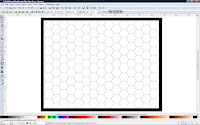
Once you have opened the file with Inkscape then click on the menu Layers->Layers... The following dialog will appear.
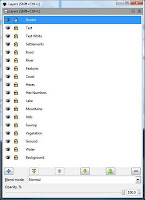
Make sure all the layers except Borders is locked.
You will notice at the bottom there is a slight gap between the bottom hexes and the top of the bottom border. This part of the tutorial is going to fix that.
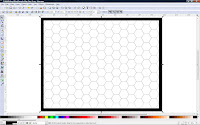
Select the Border you will see eight selection arrows around it.
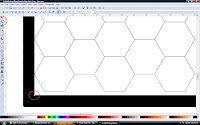
Zoom into the lower right corner by using the View Menu or holding down the CTRL key while scrolling the mouse wheel.
Click on the Edit Paths by Node tool in the toolbar to the left. It is the second one down. You will see diamonds appear on all the corners.

Click the inner diamond on the lower left corner. Then look on the top toolbar change the units from pixels to inches.
Hold down the CTRL key. While holding down the CTRL drag the inner diamond until the line just touches the bottommost hex.
Holding down the CTRL key constrains the dragging in one direction. It is useful for adjusting rectangular shapes like the borders.
After this look at the Y dimension in the top toolbar. Write it down.
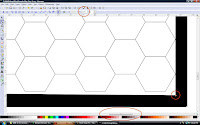
Use the bottom scroll bar to shift to the lower right corner. Select the Inner Diamond. In the Y dimension on the top toolbar type in the number you recorded from the previous step. Now you have a nice even bottom border again.
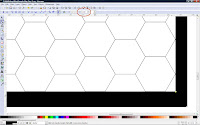
The final result can be downloaded from here.
Again the reason for this that the proportion of your hex grid is not going fit exactly in your initial border. So after drawing the hex grid you will need to fix up your border to fill in the gaps.
The next tutorial will involve creating your initial sketch map, scanning it in and setting it up to be drawn on.
First bring up the map you created from the second part of this tutorial or download Sample Map 2 Remember to right click and use Save Link As.. This is an SVG files which most browsers can display.

Once you have opened the file with Inkscape then click on the menu Layers->Layers... The following dialog will appear.

Make sure all the layers except Borders is locked.
You will notice at the bottom there is a slight gap between the bottom hexes and the top of the bottom border. This part of the tutorial is going to fix that.

Select the Border you will see eight selection arrows around it.

Zoom into the lower right corner by using the View Menu or holding down the CTRL key while scrolling the mouse wheel.
Click on the Edit Paths by Node tool in the toolbar to the left. It is the second one down. You will see diamonds appear on all the corners.

Click the inner diamond on the lower left corner. Then look on the top toolbar change the units from pixels to inches.
Hold down the CTRL key. While holding down the CTRL drag the inner diamond until the line just touches the bottommost hex.
Holding down the CTRL key constrains the dragging in one direction. It is useful for adjusting rectangular shapes like the borders.
After this look at the Y dimension in the top toolbar. Write it down.

Use the bottom scroll bar to shift to the lower right corner. Select the Inner Diamond. In the Y dimension on the top toolbar type in the number you recorded from the previous step. Now you have a nice even bottom border again.

The final result can be downloaded from here.
Again the reason for this that the proportion of your hex grid is not going fit exactly in your initial border. So after drawing the hex grid you will need to fix up your border to fill in the gaps.
The next tutorial will involve creating your initial sketch map, scanning it in and setting it up to be drawn on.
Friday, October 31, 2008
Mapping Tutorial #2 (Setting up your hexes)
Welcome the second in a series of tutorials on how to use a vector drawing program to do maps. The program we are using is Inkscape which is freely available.
First bring up the map you created from the first part of this tutorial or download Sample Map 1
Remember to right click and use Save Link As.. This is an SVG files which most browsers can display.
Once you have opened the file with Inkscape then click on the menu Layers->Layers... The following dialog will appear.
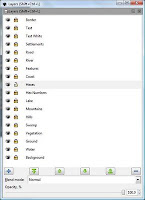
Make sure that Hexes is unlocked AND highlighted in blue.
Now click on the menu File->Document Properties

A dialog will appear.
Click on the Snap tab and make sure it looks like below. You will likely need to click on Snap to Nodes (it is in the middle of the dialog).
Then click the red X in the upper right corner.
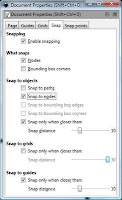
Then click on the Stars and Polygon tool on the left side of the screen.
In the upper left corner, click on the star and then the polygon. There is some odd issues with Inkscape that causes you to draw a star despite having the polygon selected. This will fix that issue.
Then make sure you change the corners to 6.
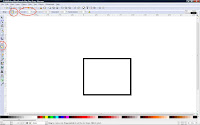
Now draw a single hex.
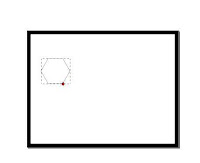
I can't really show this so you will have bear with me.
1) Click and HOLD DOWN the left mouse button anywhere where it is white.
2) With the opposite hand hold down the control key.
3) Drag the mouse you will see the hex increasing in size and rotating.
4) Because you are holding down the control key it will only rotate in 15 degree increments.
Rotate it so the top and bottom are flat. The size is not an issue just stop when you have the top and bottom flat.
5) Release the left mouse button .
You have your first hex.
Now you will have to decide how many hexes you want from top to bottom. For this tutorial I am picking ten hexes. The actual number will depend on your scale and the region you are making up.
Now select the hex by clicking on it.
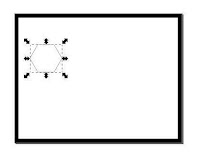
Go down to the lower left corner and right click the black color. Click Set Stroke. This will make the border of the hex black. Later one we may want to change it to a shade of gray to lower the contrast with the coastline and other features of the map.
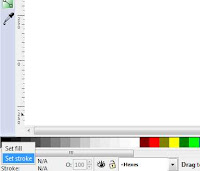
Then click on the menu Edit->Copy
Then click on the menu Edit->Paste
You will see a second hex appear.
Drag it underneath the first hex. Drag it so that one of the upper corner is near one of the first hex's lower corners. At some point when they are close enough you will see the second hex snap into place along the bottom.
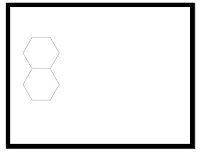
Release the mouse button.
Congratulations you have your second hex nicely aligned with the first one.
Do this until you have a column of ten hexes.
Make sure you have the arrow tool (the topmost tool) selected.
Draw a selection box around the column. Then click the menu Object->Group. This will unite all ten hexes into a single group.
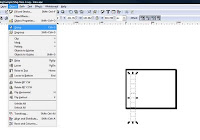
Then click the menu Edit->Copy

Then click Edit->Paste.
Drag the column so that it dovetails with the first column. The even columns will be a half hex lower and the odd Columns the same height as the first column. You want about 15 columns like below.
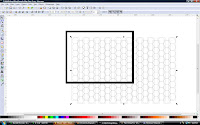
Using the Arrow Tool select all the hexes.
Click on Object->Group. This will unite all the columns until one large hex grid.
Now drag the grid so that the upper left corner is near the inside upper left corner of the border.
Zoom in using the View Menu or by holding down the Control Key and moving your mouse wheel.
When you are zoomed in. Drag the hex grid so that the top edge and the left corner of the upper left hex touches the border perfectly. This is shown below.
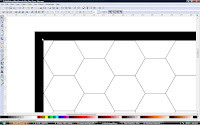
Then zoom out until you can see everything.
You will notice that your hexgrid has eight selection handles. Grab the lower right one with your mouse. Hold down the control key and drag the corner. You want to fit rows as close as you can to the top and bottom inside edges of the border. As well as having the right corner of a column of hexes touching the inside right edge of the border. If you have done it correctly the result will be as below.
The control key keeps the proportions of the resizing objects even so your hexes don't get distorted.
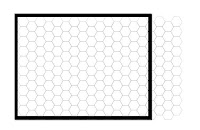
It is ok if the top and bottom edges of the hex columns don't quite touch. We will fix that in a later step. But you will see that we have a lot of extra columns and a few extra on the bottom.
You want to click the menu Object->Ungroup about three or four times so that we are ungroup down to the individual hexes.
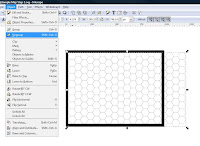
Start selecting any hexes that lay outside of the border and delete them.
The result should be this. Save your map and we are done with tutorial #2.
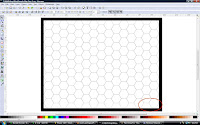
It is not easy to get the right proportions for a hex grid so always include extra columns and rows to have maximum flexibility.
Invariably you will have small gaps between the edges of the hex grid and the border. We can fix this and will do so in the next tutorial. After we are getting into the actual drawing of the map.
The final result can be downloaded from here.
Part 3
First bring up the map you created from the first part of this tutorial or download Sample Map 1
Remember to right click and use Save Link As.. This is an SVG files which most browsers can display.
Once you have opened the file with Inkscape then click on the menu Layers->Layers... The following dialog will appear.

Make sure that Hexes is unlocked AND highlighted in blue.
Now click on the menu File->Document Properties

A dialog will appear.
Click on the Snap tab and make sure it looks like below. You will likely need to click on Snap to Nodes (it is in the middle of the dialog).
Then click the red X in the upper right corner.

Then click on the Stars and Polygon tool on the left side of the screen.
In the upper left corner, click on the star and then the polygon. There is some odd issues with Inkscape that causes you to draw a star despite having the polygon selected. This will fix that issue.
Then make sure you change the corners to 6.

Now draw a single hex.

I can't really show this so you will have bear with me.
1) Click and HOLD DOWN the left mouse button anywhere where it is white.
2) With the opposite hand hold down the control key.
3) Drag the mouse you will see the hex increasing in size and rotating.
4) Because you are holding down the control key it will only rotate in 15 degree increments.
Rotate it so the top and bottom are flat. The size is not an issue just stop when you have the top and bottom flat.
5) Release the left mouse button .
You have your first hex.
Now you will have to decide how many hexes you want from top to bottom. For this tutorial I am picking ten hexes. The actual number will depend on your scale and the region you are making up.
Now select the hex by clicking on it.

Go down to the lower left corner and right click the black color. Click Set Stroke. This will make the border of the hex black. Later one we may want to change it to a shade of gray to lower the contrast with the coastline and other features of the map.

Then click on the menu Edit->Copy
Then click on the menu Edit->Paste
You will see a second hex appear.
Drag it underneath the first hex. Drag it so that one of the upper corner is near one of the first hex's lower corners. At some point when they are close enough you will see the second hex snap into place along the bottom.

Release the mouse button.
Congratulations you have your second hex nicely aligned with the first one.
Do this until you have a column of ten hexes.
Make sure you have the arrow tool (the topmost tool) selected.
Draw a selection box around the column. Then click the menu Object->Group. This will unite all ten hexes into a single group.

Then click the menu Edit->Copy

Then click Edit->Paste.
Drag the column so that it dovetails with the first column. The even columns will be a half hex lower and the odd Columns the same height as the first column. You want about 15 columns like below.

Using the Arrow Tool select all the hexes.
Click on Object->Group. This will unite all the columns until one large hex grid.
Now drag the grid so that the upper left corner is near the inside upper left corner of the border.
Zoom in using the View Menu or by holding down the Control Key and moving your mouse wheel.
When you are zoomed in. Drag the hex grid so that the top edge and the left corner of the upper left hex touches the border perfectly. This is shown below.

Then zoom out until you can see everything.
You will notice that your hexgrid has eight selection handles. Grab the lower right one with your mouse. Hold down the control key and drag the corner. You want to fit rows as close as you can to the top and bottom inside edges of the border. As well as having the right corner of a column of hexes touching the inside right edge of the border. If you have done it correctly the result will be as below.
The control key keeps the proportions of the resizing objects even so your hexes don't get distorted.

It is ok if the top and bottom edges of the hex columns don't quite touch. We will fix that in a later step. But you will see that we have a lot of extra columns and a few extra on the bottom.
You want to click the menu Object->Ungroup about three or four times so that we are ungroup down to the individual hexes.

Start selecting any hexes that lay outside of the border and delete them.
The result should be this. Save your map and we are done with tutorial #2.

It is not easy to get the right proportions for a hex grid so always include extra columns and rows to have maximum flexibility.
Invariably you will have small gaps between the edges of the hex grid and the border. We can fix this and will do so in the next tutorial. After we are getting into the actual drawing of the map.
The final result can be downloaded from here.
Part 3
Wednesday, October 29, 2008
Mapping Tutorial #1 (Setting up your drawing)
Welcome to Part 1 of a series of Mapping Tutorials.
We are going to be using a piece of software called Inkscape.
Inkscape is a open source Vector Drawing Package available for free at http://www.inkscape.org
It has a lot of nice features comparable to other vector drawing software like Adobe Illustrator and Corel. While the commercial packages have many more nifty features Inkscape has everything we need for mapping and it is free!
Download the latest version and install it. When you run the software you will see the following screen.
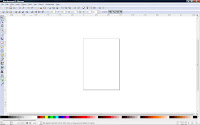
First you do is click on the menu File then Save. Give it a name like Document Template or Sample Map.
Now we need to setup the basics.
Click on the menu File->Document Properties

The following dialog will appear.
Change the page size to US Letter and the Page Orientation to Landscape. After you are done click the Red X in the upper right corner.
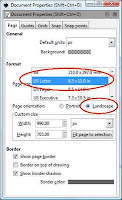
Next click on the menu Layer->Layer... (it's all the way at the bottom)

You will see a dialog appear on the right side of the screen. This is called a docker and it docks to one side or the other. Drag it out of there by dragging the title bar. Then goto the lower right corner and drag it until it fill 2/3 of your screen from top to bottom.
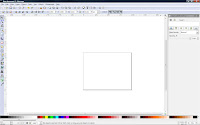
You will see this. Now use the blue + 'plus' button to add a layout, name it Background. This several more times adding the following layers
Water, Ground, Vegetation, Swamp, Hills, Mountains, Lake, Hex Numbers, Hexes, Coast, Features, River, Road, Settlements, Text White, Text, Border.
After you add the layers scroll through what you added and click the lock symbol. It is circled in red below. The lock symbol locks that layer so that you can't draw on it. This prevents drawing on the wrong layer.
In the cut and paste days with glue and paper layers are like films of acetate. You build up your map or presentation by starting with a bottom sheet of acetate layering each successive sheet on top until the drawing was finished.
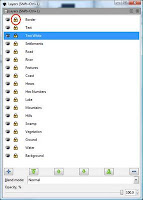
Then click the Border layer and click the lock system to unlock it. Make sure it is highlighted in blue. Then click the Red X in the upper right corner.

In the lower left corner there are two fields call Fill and Stroke. Fill control what color is the inside of a shape, Stroke controls the color of the border. For now we want the stroke black and the fill set to n/a
First click the rectangle tool on the left side of the screen. Then go down to the lower left and right click fill. On the menu make sure you click Remove Fill at the bottom. Then move up to the the color strip and right click black. On the menu click set stroke.
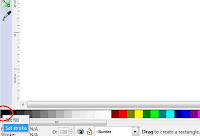
Next use the rectangle tool and draw a rectangle anywhere on the page. You click and then drag to form the rectangle.
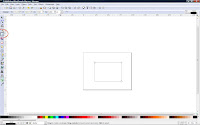
Next click the arrow tool at the top of the tool strip on the left side of the screen. Click on the rectangle. You see selection handle appear around the rectangle.
Finally look at the second toolbar down from the top.
You will see four fields in the middle of the toolbar. This will show the dimensions of the rectangle you just drew. Go to the last field which is a drop down list. Click the down arrow and pick in (inches).
Then for the other four fields make X 0 (zero). Y 0 ,W (width) 11, H (Height) 8.5
See below how this looks
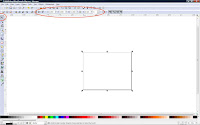
Then click on the menu Edit->Copy. Note you not see any visible change here.

Make sure you are still on the Arrow tool on the left side of the screen. Click anywhere OUTSIDE of the rectangle. You will see the eight selection handle disappear.
Then click the Menu Edit->Paste

You will see something like below.
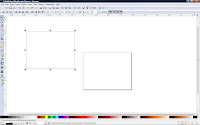
Next change the fields for this rectangle as follows
X .25, Y .25, W (width) 10.5, H (height) 8.0

Then move the cursor well outside of the two rectangles. Hold down the left mouse button while the cursor is up and to the left of the two rectangles and then DRAG the mouse. As you drag you will see a dashed box appear. This is a selection box. Drag it until it surrounds both rectangles and release the left mouse button.

The bottom bar will report that you will have two objects selected.

If this is the case then click the menu Path->Difference. You will not see any visible changes other than the message at the bottom will change to Path (8 nodes) in layer BORDER.
What this does make the smaller rectangle punch out a hole in the larger rectangle. This means any objects that are layered below the border will show through the punched out area.

Click on black in the color strip at the bottom of the screen.
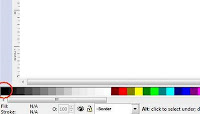
You will see the following
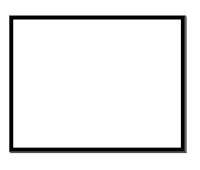
Now click on the menu Layer->Layers...
The following appears.
First Lock Borders
Next click on Hexes and it will be highlighted in blue.
Unlock Hexes by clicking the lock/unlock symbol next to the name.
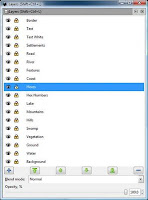
Now save the file.
You are ready for Part 2.
What we just did is draw a 1/4 inch border around our drawing. For most printers or projects there is some amount of spaces that you can't print on. Usually it is about 1/4. By defining this border you know where the bounds are. Also it gives teh resulting map a pleasant looking boundary. As you become more proficent you may want to experiment with fancier or thick borders.
You can download the finished drawing from here http://www.ibiblio.org/mscorbit/map/Sample Map Step.svg
Note that you will have to right click the link and on the menu click Save Target As. This is because many web browser can display the svg format that Inkscape uses.
Part II
We are going to be using a piece of software called Inkscape.
Inkscape is a open source Vector Drawing Package available for free at http://www.inkscape.org
It has a lot of nice features comparable to other vector drawing software like Adobe Illustrator and Corel. While the commercial packages have many more nifty features Inkscape has everything we need for mapping and it is free!
Download the latest version and install it. When you run the software you will see the following screen.

First you do is click on the menu File then Save. Give it a name like Document Template or Sample Map.
Now we need to setup the basics.
Click on the menu File->Document Properties

The following dialog will appear.
Change the page size to US Letter and the Page Orientation to Landscape. After you are done click the Red X in the upper right corner.

Next click on the menu Layer->Layer... (it's all the way at the bottom)

You will see a dialog appear on the right side of the screen. This is called a docker and it docks to one side or the other. Drag it out of there by dragging the title bar. Then goto the lower right corner and drag it until it fill 2/3 of your screen from top to bottom.

You will see this. Now use the blue + 'plus' button to add a layout, name it Background. This several more times adding the following layers
Water, Ground, Vegetation, Swamp, Hills, Mountains, Lake, Hex Numbers, Hexes, Coast, Features, River, Road, Settlements, Text White, Text, Border.
After you add the layers scroll through what you added and click the lock symbol. It is circled in red below. The lock symbol locks that layer so that you can't draw on it. This prevents drawing on the wrong layer.
In the cut and paste days with glue and paper layers are like films of acetate. You build up your map or presentation by starting with a bottom sheet of acetate layering each successive sheet on top until the drawing was finished.

Then click the Border layer and click the lock system to unlock it. Make sure it is highlighted in blue. Then click the Red X in the upper right corner.

In the lower left corner there are two fields call Fill and Stroke. Fill control what color is the inside of a shape, Stroke controls the color of the border. For now we want the stroke black and the fill set to n/a
First click the rectangle tool on the left side of the screen. Then go down to the lower left and right click fill. On the menu make sure you click Remove Fill at the bottom. Then move up to the the color strip and right click black. On the menu click set stroke.

Next use the rectangle tool and draw a rectangle anywhere on the page. You click and then drag to form the rectangle.

Next click the arrow tool at the top of the tool strip on the left side of the screen. Click on the rectangle. You see selection handle appear around the rectangle.
Finally look at the second toolbar down from the top.
You will see four fields in the middle of the toolbar. This will show the dimensions of the rectangle you just drew. Go to the last field which is a drop down list. Click the down arrow and pick in (inches).
Then for the other four fields make X 0 (zero). Y 0 ,W (width) 11, H (Height) 8.5
See below how this looks

Then click on the menu Edit->Copy. Note you not see any visible change here.

Make sure you are still on the Arrow tool on the left side of the screen. Click anywhere OUTSIDE of the rectangle. You will see the eight selection handle disappear.
Then click the Menu Edit->Paste

You will see something like below.

Next change the fields for this rectangle as follows
X .25, Y .25, W (width) 10.5, H (height) 8.0

Then move the cursor well outside of the two rectangles. Hold down the left mouse button while the cursor is up and to the left of the two rectangles and then DRAG the mouse. As you drag you will see a dashed box appear. This is a selection box. Drag it until it surrounds both rectangles and release the left mouse button.

The bottom bar will report that you will have two objects selected.

If this is the case then click the menu Path->Difference. You will not see any visible changes other than the message at the bottom will change to Path (8 nodes) in layer BORDER.
What this does make the smaller rectangle punch out a hole in the larger rectangle. This means any objects that are layered below the border will show through the punched out area.

Click on black in the color strip at the bottom of the screen.

You will see the following

Now click on the menu Layer->Layers...
The following appears.
First Lock Borders
Next click on Hexes and it will be highlighted in blue.
Unlock Hexes by clicking the lock/unlock symbol next to the name.

Now save the file.
You are ready for Part 2.
What we just did is draw a 1/4 inch border around our drawing. For most printers or projects there is some amount of spaces that you can't print on. Usually it is about 1/4. By defining this border you know where the bounds are. Also it gives teh resulting map a pleasant looking boundary. As you become more proficent you may want to experiment with fancier or thick borders.
You can download the finished drawing from here http://www.ibiblio.org/mscorbit/map/Sample Map Step.svg
Note that you will have to right click the link and on the menu click Save Target As. This is because many web browser can display the svg format that Inkscape uses.
Part II
Monday, October 27, 2008
Mapping with Hexes
Hex Paper - one of the signature items of the RPG hobby. Originating in the board and counter games of Avalon Hill, hexes formed the basis for mapping nearly all of the early settings. When miniatures returned to widespread use in RPGs hexes were scaled up to be used on battle mats.
Rob's Note: An updated version of this post is an appendix in How to Make a Fantasy Sandbox.
For mapping there is a big gotcha in using hexes. Unlike grids it is not as straight forward to use when you are drawing multiple maps to be joined or expanding the scale of a larger map. The advantage of using hexes was that it offered quick and easy management of sub maps and handling movement.
Note: You can click on the thumbnail to get a full image.
There are two types of hex grids
Horizontal

Vertical

Of the two vertical is by far the most popular used. The examples in this post will be using the vertical hex grid.
Hexgrids have several choices how they can be formed.
These are rectangular hex grids.
You can make the end columns even in number.
 or
or
You can make the ends uneven in length.

The last arrangement is used when you sub dived a large hex into smaller hexes.
Joining Maps
If you are just mapping one region and that all then you don' t need to worry about how to join two hex maps together. However if it is going to take multiple maps to completely cover your campaign then this issue needs attention
Unlike rectangular maps hex maps will have some degree of overlapping. This is because for vertical hex grids the top and bottom are uneven. It is possible not to overlap however you have to alternate two different hex grids.

There are two other ways of handling the vertical joining of two hex grids.
A half overlap

A full overlap

Of the two I prefer the half overlap. It slightly spreads out the vertical coverage of each individual map and I only have to copy the top and bottom hex every other column.
The horizontal joining has several types.
If you use a hex grid with uneven numbers of hexes you can lay them side by side with no overlap.

Judges Guild in the Wilderlands of High Fantasy was one of the first publishers to deal with this issue. They used 18 hex maps arranged in a three maps across 6 maps vertically. Each Hex maps had 52 columns, and 34 rows on the odd columns (1,3,5, etc) and 33 rows on the even columns. The resulting hex grid had uneven ends on the left and right edges.
They decided to use the half overlap to join the maps on the top and bottom edge. However they messed up on the left and right edge and decided to make them overlap. Because of the even ends of the hex grid this resulted in a staircase effect as below. Each map to east was a half row south of the map to the west.

For hex grids that have even ends you can do a full overlap of the last hex column with the first hex column of the next map.

I prefer the full overlap option as it helps ensure that I am correctly drawing from one map to the next. The same reason applies to the half overlap option.
Numbering Hexes
For vertical hex grids the numbering system is XXYY where XX is the column number and YY is the row number. This is reversed for horizontal hex grids.

Sub-maps
Judges Guild is famed for having a complete mapping system that goes from campaign level of 5 miles per hex to a regional level of .2 miles per hex and finally to a local level of 42.24 feet per hex. Each larger hex was subdivided by smaller hexes 1/25 th the size of the larger hex. Hence the odd number at the local level.
If your scale per hex is an odd number (5 miles, 25 miles, etc) it is easy to draw up a subdivided hex as shown below. You pick a center hexes and count the remaining hexes outwards. You can use the six points to draw up the six sides of the larger hex.

Hexes with a even scale (10 miles, 30 miles, etc) are not as easy to subdivide. The lines you will be drawing for the sides will be meeting in the center of hexes.

There is alternative for drawing even scale hexes but you will lose the center hex. You will have decide which form is best to use for you game.

For mapping there is a big gotcha in using hexes. Unlike grids it is not as straight forward to use when you are drawing multiple maps to be joined or expanding the scale of a larger map. The advantage of using hexes was that it offered quick and easy management of sub maps and handling movement.
Note: You can click on the thumbnail to get a full image.
There are two types of hex grids
Horizontal

Vertical

Of the two vertical is by far the most popular used. The examples in this post will be using the vertical hex grid.
Hexgrids have several choices how they can be formed.
These are rectangular hex grids.
You can make the end columns even in number.
 or
or
You can make the ends uneven in length.

The last arrangement is used when you sub dived a large hex into smaller hexes.
Joining Maps
If you are just mapping one region and that all then you don' t need to worry about how to join two hex maps together. However if it is going to take multiple maps to completely cover your campaign then this issue needs attention
Unlike rectangular maps hex maps will have some degree of overlapping. This is because for vertical hex grids the top and bottom are uneven. It is possible not to overlap however you have to alternate two different hex grids.

There are two other ways of handling the vertical joining of two hex grids.
A half overlap

A full overlap

Of the two I prefer the half overlap. It slightly spreads out the vertical coverage of each individual map and I only have to copy the top and bottom hex every other column.
The horizontal joining has several types.
If you use a hex grid with uneven numbers of hexes you can lay them side by side with no overlap.

Judges Guild in the Wilderlands of High Fantasy was one of the first publishers to deal with this issue. They used 18 hex maps arranged in a three maps across 6 maps vertically. Each Hex maps had 52 columns, and 34 rows on the odd columns (1,3,5, etc) and 33 rows on the even columns. The resulting hex grid had uneven ends on the left and right edges.
They decided to use the half overlap to join the maps on the top and bottom edge. However they messed up on the left and right edge and decided to make them overlap. Because of the even ends of the hex grid this resulted in a staircase effect as below. Each map to east was a half row south of the map to the west.

For hex grids that have even ends you can do a full overlap of the last hex column with the first hex column of the next map.

I prefer the full overlap option as it helps ensure that I am correctly drawing from one map to the next. The same reason applies to the half overlap option.
Numbering Hexes
For vertical hex grids the numbering system is XXYY where XX is the column number and YY is the row number. This is reversed for horizontal hex grids.

Sub-maps
Judges Guild is famed for having a complete mapping system that goes from campaign level of 5 miles per hex to a regional level of .2 miles per hex and finally to a local level of 42.24 feet per hex. Each larger hex was subdivided by smaller hexes 1/25 th the size of the larger hex. Hence the odd number at the local level.
If your scale per hex is an odd number (5 miles, 25 miles, etc) it is easy to draw up a subdivided hex as shown below. You pick a center hexes and count the remaining hexes outwards. You can use the six points to draw up the six sides of the larger hex.

Hexes with a even scale (10 miles, 30 miles, etc) are not as easy to subdivide. The lines you will be drawing for the sides will be meeting in the center of hexes.

There is alternative for drawing even scale hexes but you will lose the center hex. You will have decide which form is best to use for you game.
